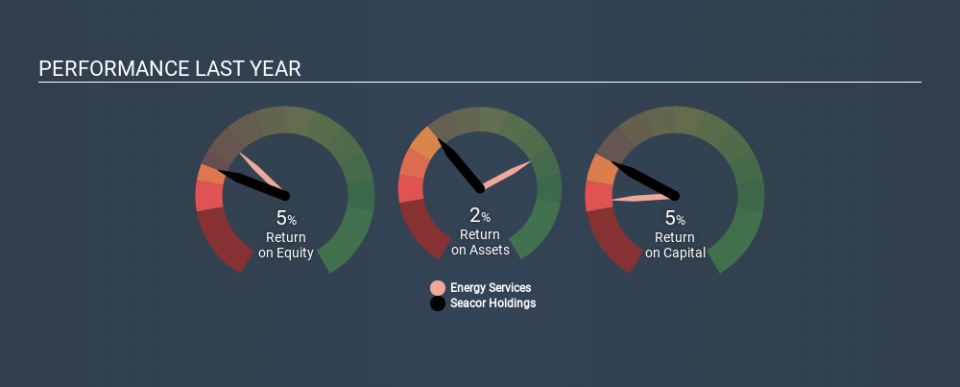Is Seacor Holdings Inc. (NYSE:CKH) Investing Your Capital Efficiently?

Today we'll look at Seacor Holdings Inc. (NYSE:CKH) and reflect on its potential as an investment. In particular, we'll consider its Return On Capital Employed (ROCE), as that can give us insight into how profitably the company is able to employ capital in its business.
First, we'll go over how we calculate ROCE. Second, we'll look at its ROCE compared to similar companies. Finally, we'll look at how its current liabilities affect its ROCE.
What is Return On Capital Employed (ROCE)?
ROCE is a metric for evaluating how much pre-tax income (in percentage terms) a company earns on the capital invested in its business. All else being equal, a better business will have a higher ROCE. Ultimately, it is a useful but imperfect metric. Renowned investment researcher Michael Mauboussin has suggested that a high ROCE can indicate that 'one dollar invested in the company generates value of more than one dollar'.
So, How Do We Calculate ROCE?
The formula for calculating the return on capital employed is:
Return on Capital Employed = Earnings Before Interest and Tax (EBIT) ÷ (Total Assets - Current Liabilities)
Or for Seacor Holdings:
0.046 = US$60m ÷ (US$1.5b - US$235m) (Based on the trailing twelve months to September 2019.)
So, Seacor Holdings has an ROCE of 4.6%.
See our latest analysis for Seacor Holdings
Is Seacor Holdings's ROCE Good?
One way to assess ROCE is to compare similar companies. In this analysis, Seacor Holdings's ROCE appears meaningfully below the 9.7% average reported by the Energy Services industry. This performance is not ideal, as it suggests the company may not be deploying its capital as effectively as some competitors. Regardless of how Seacor Holdings stacks up against its industry, its ROCE in absolute terms is quite low (especially compared to a bank account). There are potentially more appealing investments elsewhere.
In our analysis, Seacor Holdings's ROCE appears to be 4.6%, compared to 3 years ago, when its ROCE was 0.8%. This makes us think the business might be improving. You can click on the image below to see (in greater detail) how Seacor Holdings's past growth compares to other companies.
When considering ROCE, bear in mind that it reflects the past and does not necessarily predict the future. Companies in cyclical industries can be difficult to understand using ROCE, as returns typically look high during boom times, and low during busts. ROCE is only a point-in-time measure. Given the industry it operates in, Seacor Holdings could be considered cyclical. Since the future is so important for investors, you should check out our free report on analyst forecasts for Seacor Holdings.
What Are Current Liabilities, And How Do They Affect Seacor Holdings's ROCE?
Liabilities, such as supplier bills and bank overdrafts, are referred to as current liabilities if they need to be paid within 12 months. Due to the way ROCE is calculated, a high level of current liabilities makes a company look as though it has less capital employed, and thus can (sometimes unfairly) boost the ROCE. To counteract this, we check if a company has high current liabilities, relative to its total assets.
Seacor Holdings has total assets of US$1.5b and current liabilities of US$235m. As a result, its current liabilities are equal to approximately 15% of its total assets. This is a modest level of current liabilities, which will have a limited impact on the ROCE.
Our Take On Seacor Holdings's ROCE
Seacor Holdings has a poor ROCE, and there may be better investment prospects out there. You might be able to find a better investment than Seacor Holdings. If you want a selection of possible winners, check out this free list of interesting companies that trade on a P/E below 20 (but have proven they can grow earnings).
For those who like to find winning investments this free list of growing companies with recent insider purchasing, could be just the ticket.
If you spot an error that warrants correction, please contact the editor at editorial-team@simplywallst.com. This article by Simply Wall St is general in nature. It does not constitute a recommendation to buy or sell any stock, and does not take account of your objectives, or your financial situation. Simply Wall St has no position in the stocks mentioned.
We aim to bring you long-term focused research analysis driven by fundamental data. Note that our analysis may not factor in the latest price-sensitive company announcements or qualitative material. Thank you for reading.

